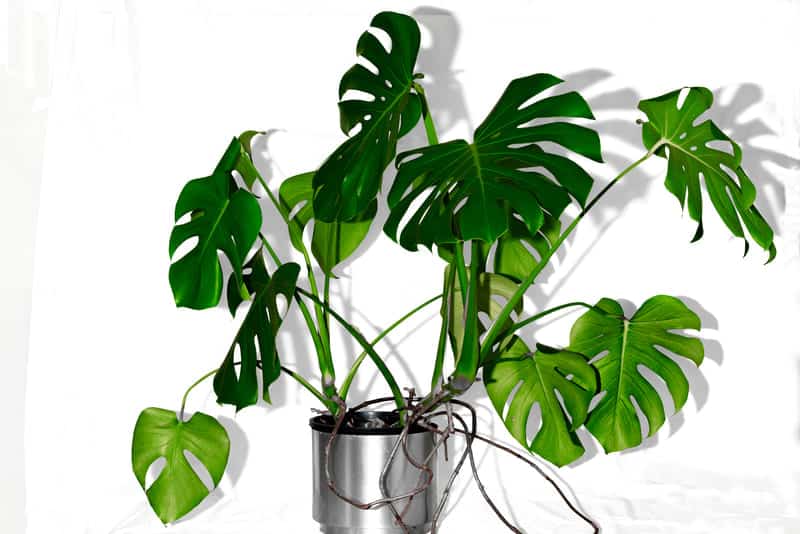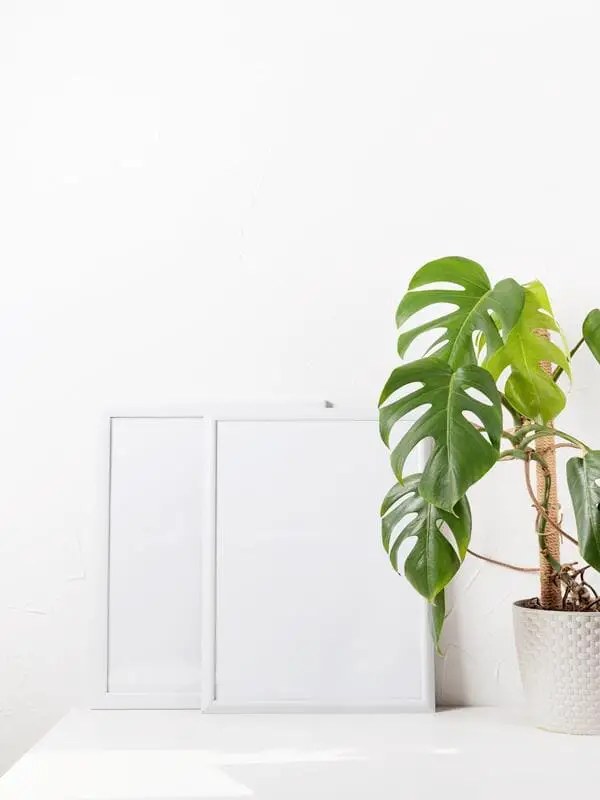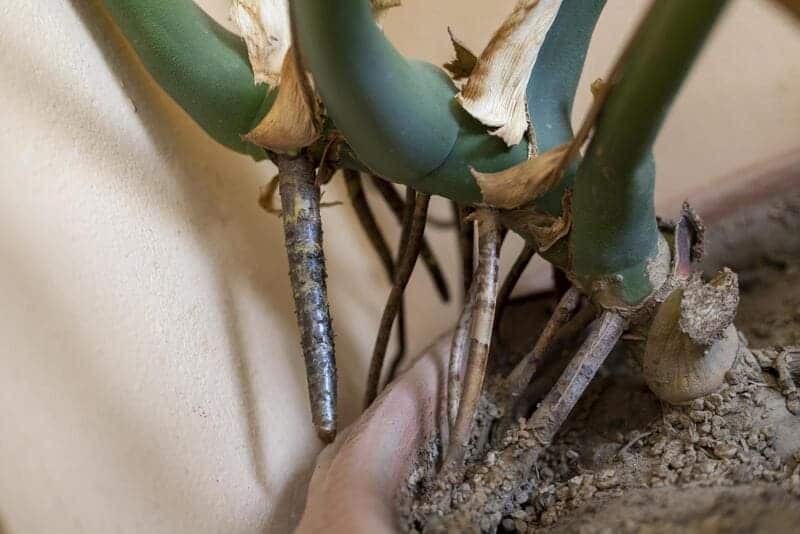With their unique leaves and low requirements for maintenance, house plants in the Monstera genus are a popular choice for both new and experienced plant lovers.
But what do you do when they start to grow roots above the soil, instead of down into it? Aerial roots can be intimidating at first if you don’t know what to do with them, so we’ve covered everything you need to know right here.
The good news is that you don’t have to do anything with aerial roots when they appear on your Monstera. If you want your house plant to continue being low-maintenance, there’s no need to worry about extra work when it starts producing these above-ground roots.
You can simply leave them be and rest easy knowing that your plant is healthy and will keep growing fine. However, these roots will continue to grow and can get lengthy, so this solution may not work for long!
With that in mind, you might be wondering what your options are. Can you cut the roots off safely without harming your plant? Or should you let them grow until you can plant them back in the soil?
Luckily, there are many choices for what to do with aerial roots, so you simply have to find a method that works best for you!
What are aerial roots?
First off, what are aerial roots and why do they grow? Aerial roots, or air roots, are roots that form along the plant stem above the soil level.
They often differ in appearance from other new growth on your plant, and Monstera aerial roots will eventually form a brown, woody exterior.
In nature, these roots grow on a variety of species for many different reasons. On vines and climbing plants, like Monstera, they help the plant cling to the side of a taller plant or tree, or rock they might be growing on.
This secures the plant in place and helps it climb up toward the sunlight, instead of being stuck on the forest floor.
Other species might grow aerial roots to absorb additional moisture from the air or use the extra surface area to exchange gasses if the below-soil roots are flooded or waterlogged for extended periods.
Even though plants need water, they still need to breathe air! Finally, aerial roots may form if a plant is attempting to spread via root.
These roots develop “clones” of the parent plant above ground and are still connected to the plant they originated from (such as strawberry plant runners).
Are aerial roots on Monstera plants good?
Many species of house plants grow aerial roots for a variety of reasons, and they usually are not considered “good” or “bad” indicators when they appear, they simply are part of the plant! Species that most often form aerial roots include Orchids, Pothos, Philodendrons, Monstera, English Ivy, Rubber Tree, and many species of succulents.
Just like in nature, there are many different reasons why your Monstera might start sprouting aerial roots. Just because it is trying to climb doesn’t mean your plant isn’t getting enough sun where it is, it might just be happy and healthy enough to grow bigger!
What do you do with Monstera aerial roots?
There are a few options for what you can do with aerial roots on a Monstera plant. These options are summarized here and will be covered in detail in the following sections. If you’ve decided you don’t want to just let them grow, you can:
- Place them in water or mist them
- Plant them back in the soil
- Trim them off to keep your plant looking tidy
- Train them to grow on a certain structure or post to help your plant grow taller, or
- Use the roots to propagate new Monstera plants
Should you put Monstera aerial roots in water?
Some sources will recommend that you place a bowl or cup of water beside your plant and place the aerial roots into that. This isn’t necessary, however (the aerial roots are happy to grow in well, the air) and can even cause some unexpected results ranging from root rot to the plant fully rooting into the water.
It is important to note that much of the knowledge surrounding house plant care is based on the shared experiences of those who grow and care for them, and not scientific studies.
Individual growing conditions, environmental factors, and the species of Monstera might all impact the response to placing aerial roots in water (as well as a variety of other things!)
If you are planning to propagate (grow a new plant from a portion of the existing one) this might be a good method to find if the cutting will be viable before you remove the roots and part of the stem to plant. We will cover this in greater detail later on.
If you want to do something with your aerial roots, you could consider increasing the humidity around the plant using a humidifier or by manually misting the plant.
This is because aerial roots may grow in order to reach additional moisture in the air, so increasing the humidity may facilitate this.
It is important to pay extra attention to your plant after you change any aspect of its care, and increasing the humidity may result in rot if it is not allowed to dry out periodically.
Some people don’t bother misting their plants due to this risk, however, you should feel free to experiment with what works best for you and your plants!
If you are concerned about how your plant will react, it is better to make slow, gradual changes and pay close attention to the response rather than changing many things all at once.
Can I put Monstera aerial roots in soil?
In nature, if Monstera plants need extra support while growing up the side of something, their aerial roots will actually grow all the way back down to the ground.
As well as anchoring the plant more securely in the soil, these roots help to increase the nutrients taken up by the plant. This is because when aerial roots make contact with soil rather than air, subterranean (underground) roots will develop into the soil from the areas of the root touching the soil surface.
You can facilitate a similar process with your Monstera aerial roots at home. Do this by allowing the roots to grow long enough until they can reach back to the pot the plant is in.
Gently place or plant the roots back into the soil once they are long enough. Since these roots will now grow into nutrient-absorbing, subterranean roots below the soil, you may want to consider repotting your plant into a larger container to allow the roots more room to grow.
A plant that becomes “root bound” (with roots too large for the container it is in) can sometimes suffer in health, so it is important to make sure your pot is big enough to accommodate these new roots!
What happens if you cut a monstera aerial root?
There is much debate on whether or not you should cut the aerial roots off of your plant completely. They don’t harm the plant and are a natural part of its growth, so why remove them?
Some individuals simply don’t like the way they look, and trimming off these roots to increase the aesthetics of your plant is essentially the same as pruning and shaping the above-ground growth of other species.
If you do decide to trim the aerial roots off of your Monstera, it is important that you do it properly to minimize the potential harm to your plant.
Whenever you cut a plant and remove the protective outer layer of growth, you potentially expose the inside tissue to pests and diseases which can weaken or even kill your plant.
This is why it is important to use clean, sharp tools to make your cuts. Cuts should have smooth edges, not jagged rips or tears, to allow for quick healing of your plant after trimming or root removal.
For aerial roots, make clean cuts close to the stem without removing the entire root or causing damage to the main plan. If you aren’t sure how your plant will respond to the trimming, remove one or two at first and see how your plant recovers, and then gradually remove the rest of the aerial roots.
You will have to repeat this process regularly as aerial roots grow faster than below-ground ones. If an aerial root is rotting, you will want to remove as much of the rotting tissue as possible to avoid it spreading to the main plant stem.
How do you train Monstera aerial roots?
Another method of managing the unruly aerial roots of a Monstera plant is to train them to climb up a surface, structure, or plant post.
Some individuals will allow climbing plants to grow up their walls. This is fine with a species like Monstera (although it might chip off some of your paint).
If you do decide to train your Monstera to grow taller, the easiest thing to do is to provide it with something suitable to grow on.
This might be a piece of furniture that you aren’t planning to move soon, like a bookcase or shelf that the plant is on, or you can put a post right into the pot with the Monstera to allow it to grow on.
These posts are often thick and covered in moss or other soft coverings, to mimic the mossy rocks and trees these plants would normally grow on.
When selecting a post or pole to train your Monstera to grow on, it is important that you pick something thick, sturdy, and secure enough to handle the weight of the plant as it grows.
Thinner props like bamboo posts are not suitable in the long term, as they will often snap under the weight of the plant.
To train your plant to grow up the pole, simply secure the stem to the pole a few times with plant ties or plant tape, making sure you only secure it tight enough to prevent it from falling over.
To really encourage upward growth, you can prune the growth on either side of the plant that is growing horizontally instead of up. The aerial roots will anchor onto the post to help support the climbing plant.
Can you propagate Monstera from aerial roots?
Finally, you can use aerial roots to propagate your Monstera to create many more mini plants. Propagation will not occur with just the root cutting, however, so you need to cut off part of the stem with at least one node included.
After you have a suitable cutting with a piece of stem and an aerial root, there are a few options for establishing your new plant.
One method is to place the aerial root into a cup of water to stimulate nutrient-absorbing root growth. You will want to change the water regularly to keep it fresh and avoid allowing the water to become murky or cloudy.
Some individuals will say that starting a cutting in water is risky and the plant will be hard to transfer to soil, but I don’t see any harm in allowing the first few roots to start in the water.
This way you don’t have to worry about keeping the cutting moist until it sprouts, and you can see right away when the roots start to develop. Once you notice some new growth, transplant the cutting into suitable soil for Monstera plants and water regularly.
The second method is to simply plant the aerial root into soil once it is cut, with the portion of the cutting with the stem at or just over the soil surface.
The benefit of this method is you don’t have to worry about transplanting the cutting from water, however, you will have to be sure you water the cutting regularly to encourage root growth into the soil.
This method is similar for many different species that produce aerial roots, such as Philodendrons, Pothos, and Orchids.



